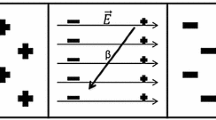Abstract
Third-generation-semiconductor zinc oxide is utilized as an energy converting material in a betavoltaic battery, where 0.06 Ci 63Ni and 8 Ci 147Pm are used as the beta sources. Based on a Monte Carlo simulation, the full scales of the devices are derived as 17 and 118 μm, respectively, for both sources. The influences of semiconductor doping concentrations on the electrical properties of the devices are analyzed. For a typical doping concentration NA= 1017 cm−3, ND= 1016 cm−3, the conversion efficiencies are 7.177% and 1.658%, respectively, using 63Ni and 147Pm sources. The calculation results of energy deposition in materials for the two sources show that the doping concentrations drop to 1 × 1013–5×1014 cm−3 and 1 × 1012–5×1013, and accordingly, the energy conversion efficiencies rise to 14.212% and 18.359%, respectively.






Similar content being viewed by others
References
S.C. Hao, Z.M. Lu, X.M. Fu et al., Nuclear battery materials and application of nuclear batteries. Nucl. Phys. Rev. 23(3), 353–358 (2006). (in Chinese)
D.R. Li, L. Jiang, J.H. Yin et al., Betavoltaic battery conversion efficiency improvement based on interlayer structures. Chin. Phys. Lett. 29(29), 78102–78105(4) (2012). https://doi.org/10.1088/0256-307x/29/7/078102
G. Gui, K. Zhang, J.P. Blanchard et al., Prediction of 4H–SiC betavoltaic microbattery characteristics based on practical Ni-63 sources. Appl. Radiat. Isot. 107, 272–277 (2016). https://doi.org/10.1016/j.apradiso.2015.11.001
L. Zhang, H.L. Cheng, X.C. Hu et al., Model and optimal design of 147 Pm SiC-based betavoltaic cell. Superlattices Microstruct. 123, 60–70 (2018). https://doi.org/10.1016/j.spmi.2018.01.007
C. Thomas, S. Portnoff, M.G. Spencer, High efficiency 4H-SiC betavoltaic power sources using tritium radioisotopes. Appl. Phys. Lett. 108(1), 013505 (2016). https://doi.org/10.1063/1.4939203
C.E. Munson, Q. Gaimard, K. Merghem et al., Modeling, design, fabrication and experimentation of a GaN-based, 63Ni betavoltaic battery. J. Phys. D Appl. Phys. 51(3), 035101 (2017). https://doi.org/10.1088/1361-6463/aa9e41
N. Ayarcı Kuruoğlu, O. Özdemir, K. Bozkurt, Betavoltaic study of a GaN p-i-n structure grown by metal-organic vapour phase epitaxy with a Ni-63 source. Thin Solid Films 636, 746–750 (2017). https://doi.org/10.1016/j.tsf.2017.07.033
B.H. Kim, J.W. Kwon, Plasmon-assisted radiolytic energy conversion in aqueous solutions. Sci. Rep. (2014). https://doi.org/10.1038/srep05249
H. Guo, H. Yang, Y. Zhang. Betavoltaic microbatteries using porous silicon, in IEEE International Conference on MICRO Electro Mechanical Systems (IEEE, 2007), pp. 867–870
X.J. Yang, X.L. Xu, J.C. Xie et al., Research of ZnO homogeneous p–n junction. J. Vac. Sci. Technol. (China) 25(s1), 101–104 (2005). (in Chinese)
Y.N. He, C.C. Zhu, X. Hou, Recent advances in characteristics of ZnO semiconductor. J. Funct. Mater. Devices 14(03), 566–574 (2008). (in Chinese)
M.A. Prelas, C.L. Weaver, M.L. Watermann et al., A review of nuclear batteries. Prog. Nucl. Energy 75, 117–148 (2014). https://doi.org/10.1016/j.pnucene.2014.04.007
H.D. Wang, Research on the On-line Coal Analysis Based on Neutron Activation and the Energy Transport of β-Voltaic Nuclear Battery (Jilin University, Changchun, 2012). (in Chinese)
H.D. Wang, Y.M. Liu, K. Yang et al., The transport of β particle in Beta- voltaic Battery. Prog. Rep. Chin. Nucl. Sci. Technol. 2, 157–164 (2011). (in Chinese)
L.P. Yang, F. Liu, H.P. Han, Research and development of ZnO. Microelectromech. Technol. 44(2), 81–87 (2007). (in Chinese)
A. Janotti, dWCG Van, Fundamentals of zinc oxide as a semiconductor. Rep. Prog. Phys. 72(12), 126501 (2009). https://doi.org/10.1088/0034-4885/72/12/126501
L.L. Chen, Z.Z. Ye, J.G. Lu et al., Control and improvement of p-type conductivity in indium and nitrogen codoped ZnO thin films. Appl. Phys. Lett. 89(25), 547 (2006). https://doi.org/10.1063/1.2405858
N. Narayanan, D.N. Kannoth, Exploring p type conductivity in ZnO thin films by In–N codoping for homo-junction devices. J. Mater. Sci.: Mater. Electron. 28(8), 1–9 (2016). https://doi.org/10.1007/s10854-016-6270-y
J.M. Bian, X.M. Li, C.Y. Zhang et al., Synthesis and characterization of two-layer-structured ZnO p–n homojunctions by ultrasonic spray pyrolysis. Appl. Phys. Lett. 84(19), 3783–3785 (2004). https://doi.org/10.1063/1.1739280
X. Yang, X. Xu, F. Liu et al., Fabrication of p-ZnO:Na/n-ZnO: Na homojunction by surface pulsed laser irradiation. RSC. Adv. 7(59), 37296–37301 (2017). https://doi.org/10.1039/C7RA05574A
J.G. Lu, Y.Z. Zhang, Z.Z. Ye et al., Low-resistivity, stable p-type ZnO thin films realized using a Li-N dual-acceptor doping method. Appl. Phys. Lett. 88, 222114 (2006). https://doi.org/10.1063/1.2209191
P.A. Wahid, An Introduction to Isotopes and Radiations (Allied Publishers, New Delhi, 2001), p. 94
J.G. Lu, Z.Z. Ye, G.D. Yuan et al., Electrical characterization of ZnO-based homojunctions. Appl. Phys. Lett. 89(5), 2203 (2006). https://doi.org/10.1063/1.2245221
G.Q. Wang, H.M. Zhang, S.Z. Luo et al., Electrical capabilities of silicon diode on irradiating. J. Isot. 21(4), 198–203 (2008). (in Chinese)
D.C. Look, Electrical and optical properties of p-type ZnO. Semicond. Sci. Tech. 20, S55–S61 (2005). https://doi.org/10.1088/0268-1242/20/4/007
X.B. Tang, Y.P. Liu, D. Ding et al., Optimization design of GaN betavoltaic microbattery. Sci China Tech Sci 55, 659–664 (2012). https://doi.org/10.1007/s11431-011-4739-8. (in Chinese)
Y.P. Liu, X.B. Tang, Z.H. Xu et al., Influences of planar source thickness on betavoltaics with different semiconductors. J. Radioanal. Nucl. Chem. 304(2), 517–525 (2015). https://doi.org/10.1007/s10967-014-3879-2
X.B. Tang, Y.P. Liu, D. Ding et al., Optimization design of GaN betavoltaic microbattery. Sci. China. Tech Sci. 55, 659–664 (2012). https://doi.org/10.1007/s11431-011-4739-8
Author information
Authors and Affiliations
Corresponding author
Additional information
This work was supported by the National Major Scientific Instruments and Equipment Development Projects (No. 2012YQ240121) and the National Natural Science Foundation of China (No. 11075064).
Rights and permissions
About this article
Cite this article
Li, XY., Lu, JB., Liu, YM. et al. Exploratory study of betavoltaic battery using ZnO as the energy converting material. NUCL SCI TECH 30, 60 (2019). https://doi.org/10.1007/s41365-019-0577-3
Received:
Revised:
Accepted:
Published:
DOI: https://doi.org/10.1007/s41365-019-0577-3




